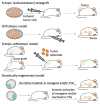Nanoparticle characterization: state of the art, challenges, and emerging technologies
- PMID: 23461379
- PMCID: PMC3672343
- DOI: 10.1021/mp300697h
Nanoparticle characterization: state of the art, challenges, and emerging technologies
Abstract
Nanoparticles have received enormous attention as a promising tool to enhance target-specific drug delivery and diagnosis. Various in vitro and in vivo techniques are used to characterize a new system and predict its clinical efficacy. These techniques enable efficient comparison across nanoparticles and facilitate a product optimization process. On the other hand, we recognize their limitations as a prediction tool, due to inadequate applications and overly simplified test conditions. We provide a critical review of in vitro and in vivo techniques currently used for evaluation of nanoparticles and introduce emerging techniques and models that may be used complementarily.
Figures



Similar articles
-
FRET as the tool for in vivo nanomedicine tracking.J Control Release. 2022 Sep;349:156-173. doi: 10.1016/j.jconrel.2022.06.048. Epub 2022 Jul 7. J Control Release. 2022. PMID: 35779657 Review.
-
Peptides and metallic nanoparticles for biomedical applications.Nanomedicine (Lond). 2007 Jun;2(3):287-306. doi: 10.2217/17435889.2.3.287. Nanomedicine (Lond). 2007. PMID: 17716175 Review.
-
Self-assembled targeted nanoparticles: evolution of technologies and bench to bedside translation.Acc Chem Res. 2011 Oct 18;44(10):1123-34. doi: 10.1021/ar200054n. Epub 2011 Jun 21. Acc Chem Res. 2011. PMID: 21692448 Review.
-
Time-Resolved Fluorescence Spectroscopy and Fluorescence Lifetime Imaging Microscopy for Characterization of Dendritic Polymer Nanoparticles and Applications in Nanomedicine.Molecules. 2016 Dec 24;22(1):17. doi: 10.3390/molecules22010017. Molecules. 2016. PMID: 28029135 Free PMC article. Review.
-
Insights into Active Targeting of Nanoparticles in Drug Delivery: Advances in Clinical Studies and Design Considerations for Cancer Nanomedicine.Bioconjug Chem. 2019 Sep 18;30(9):2300-2311. doi: 10.1021/acs.bioconjchem.9b00456. Epub 2019 Sep 6. Bioconjug Chem. 2019. PMID: 31441642 Review.
Cited by
-
Optimization and Evaluation of Poly(lactide-co-glycolide) Nanoparticles for Enhanced Cellular Uptake and Efficacy of Paclitaxel in the Treatment of Head and Neck Cancer.Pharmaceutics. 2020 Aug 30;12(9):828. doi: 10.3390/pharmaceutics12090828. Pharmaceutics. 2020. PMID: 32872639 Free PMC article.
-
Real-time analysis of composite magnetic nanoparticle disassembly in vascular cells and biomimetic media.Proc Natl Acad Sci U S A. 2014 Mar 18;111(11):4245-50. doi: 10.1073/pnas.1324104111. Epub 2014 Mar 3. Proc Natl Acad Sci U S A. 2014. PMID: 24591603 Free PMC article.
-
Characterizing Single Polymeric and Protein Nanoparticles with Surface Plasmon Resonance Imaging Measurements.ACS Nano. 2017 Jul 25;11(7):7447-7456. doi: 10.1021/acsnano.7b03859. Epub 2017 Jul 12. ACS Nano. 2017. PMID: 28692253 Free PMC article.
-
Robust passive and active efflux of cellular cholesterol to a designer functional mimic of high density lipoprotein.J Lipid Res. 2015 May;56(5):972-85. doi: 10.1194/jlr.M054635. Epub 2015 Feb 4. J Lipid Res. 2015. PMID: 25652088 Free PMC article.
-
Release kinetics study of poorly water-soluble drugs from nanoparticles: are we doing it right?Mol Pharm. 2015 Mar 2;12(3):997-1003. doi: 10.1021/mp500817h. Epub 2015 Feb 17. Mol Pharm. 2015. PMID: 25658769 Free PMC article.
References
-
- Dynamic Light Scattering. An introduction in 30 minutes. Malvern Instruments; [Accessed on 11/1/12]. http://www.malvern.com/malvern/kbase.nsf/allbyno/KB000734?opendocument.
-
- Dynamic Light Scattering. Common Terms Defined (MRK 1764-01) [Accessed on 11/1/12];Malvern Instruments. http://www.malvern.com/common/downloads/campaign/MRK1764-01.pdf.
-
- Lu XY, Wu DC, Li ZJ, Chen GQ. Polymer nanoparticles. Prog Mol Biol Transl Sci. 2011;104:299–323. - PubMed
-
- Hoo CM, Starostin N, West P, Mecartney ML. A comparison of atomic force microscopy (AFM) and dynamic light scattering (DLS) methods to characterize nanoparticle size distributions. J Nanopart Res. 2008;10:89–96.
-
- Mahl D, Diendorf J, Meyer-Zaika W, Epple M. Possibilities and limitations of different analytical methods for the size determination of a bimodal dispersion of metallic nanoparticles. Colloid Surface A. 2011;377:386–392.
Publication types
MeSH terms
Grants and funding
LinkOut - more resources
Full Text Sources
Other Literature Sources

